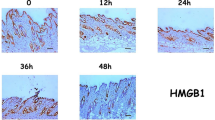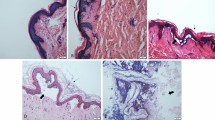Abstract
Demonstrating the vital character of an injury and estimation of the age are routine tasks in forensic pathology and although many different techniques have been applied to this problem none have been found to be completely satisfactory. Apoptosis, an active genetically controlled process, is the major mechanism by which homeostasis of a number of physiological systems in the body is regulated and changes in the rate following different kinds of stimuli have prompted us to test it as an indicator of vitality. We used an in situ end-labelling technique (Apop-Tag) in 30 human surgical skin injuries with age since injury ranging from 3 min to 8 h and found that apoptotic keratinocytes are found in over 50% of the cases with a post-infliction interval of at least 120 min. Apoptosis was not seen in injuries less than 120 min old or in normal skin, which was used as an external control. These results suggest that apoptosis could be a useful indicator for the intravital occurrence of injuries and could help to estimate the date of the skin injuries in some cases. The importance of strict technical control is stressed and the necessity of a complementary technique to confirm apoptosis is discussed.
Similar content being viewed by others
References
Betz P (1995) Immunohistochemical parameters for the age estimation of human skin wounds: a review. Am J Forensic Med Pathol 16:203–239
Betz P, Nerlich A, Tübel J, Wiest I, Hausmann R (1997) Detection of cell death in human skin wounds of various ages by an in situ end labeling of muclear DNA fragments. Int J Legal Med 110:240–243
Gavrieli Y, Sherman Y, Ben-Sasson SA (1992) Identification of programmed cell death in situ via specific labeling of nuclear DNA fragmentation. J Cell Biol 119:493–501
Gniadecki R, Hansen M, Wulf HC (1997) Two pathways for induction of apoptosis by ultraviolet radiation in cultured human keratinocytes. J Invest Dermatol 109:163–169
Grinnell F (1992) Wound repair, keratinocyte, activation and integrin modulation. J Cell Sci 101:1–5
Hausmann R, Betz P (2000) The time course of the vascular response to human brain injury — an immunohistochemical study. Int J Legal Med 113:228–292
Hausmann R, Betz P (2001) The course of glial immunoreactivity for vimentin, tenascin and alpha-1-antichymotrypsin after traumatic injury of human brain. Int J Legal Med 114:338–342
Hausmann R, Riess R, Fieguth A, Betz P (2001) Immunohistochemical investigations on the course of astroglial GFAP expression following human brain injury. Int J Legal Med 113: 70–75
Juhasz I, Murphy GF, Yan HC, Herlyn M, Albelda SM (1993) Regulation of extracellular matrix proteins and integrin cell substratum adhesion receptors on epithelium during cutaneous human wound healing in vivo. Am J Pathol 143:1458–1469
Kerr JFR, Wyllie AH, Currie AR (1972) Apoptosis: a basic biological phenomenon with wide-ranging implications in tissue kinetics. Br J Cancer 26:239–247
Lu YP, Lou YR, Yen P, Mitchell D, Huang MT, Conney AH (1999) Time course for early adaptative responses to ultraviolet B light in the epidermis of SKH-1 mice. Cancer Res 59: 4591–4602
McCall C, Cohen JJ (1991) Programmed cell death in terminal differentiated keratinocytes: role of endogenous endonuclease. J Invest Dermatol 97:111–114
Nagata M, Takenaka H, Shibagaki R, Kishimoto S (1999) Apoptosis and p53 protein expression increase in the process of burn healing in guinea-pig skin. Br J Dermatol 140:829–838
Norris DA (1995) Differential control of cell death in the skin. Arch Dermatol 131:945–948
O’Grady A, Kay EW, McKenna DB, Bennet MA, Murphy GM, Leader MB (1988) Altered expression of the p53-regulated proteins, p21 Waf1/Cip1, MDM 2 and Bax in ultraviolet-irradiated human skin. Hum Pathol 29:559–564
Okamoto H, Mizuno K, Itoh T, Tanaka K, Horio T (1999) Evaluation of apoptotic cells induced by ultraviolet light B radiation in epidermal sheets stained by the TUNEL technique. J Invest Dermatol 113:802–807
Ouhtit A, Muller HK, Davis DW, Ullrich SE, McConkey D, Ananthaswamy HN (2000) Temporal events in skin injury and the early adaptive responses in ultraviolet-irradiated mouse skin. Am J Pathol 156:201–207
Petito CK, Roberts B (1995) Effect of postmortem interval on in situ end-labeling of DNA oligonucleosomes. J Neuropathol Exp Neurol 54:761–765
Pravdenkova SV, Basnakian AG, James SJ, Andersen BJ (1996) DNA fragmentation and nuclear endonuclease activity in rat brain after severe closed head injury. Brain Res 729:151–155
Raekalio J (1972) Determination of the age of wounds by histochemical and biochemical methods. Forensic Sci Int 1:3–7
Sato Y, Ohshima T (2000) The expression of mRNA of proinflamatory cytokines during skin wound healing in mice: a preliminary study for forensic wound age stimation (II). Int J Legal Med 113:140–145
Sauroja I, Jansen C, Punnonen K (1999) UV irradiation induces downregulation of bcl-2 expression in vitro and in vivo, Arch Dermatol Res 291:212–216
Sawaguchi T, Jasani B, Kobayashi M, Knight B (2000) Postmortern analysis of apoptotic changes associated with human skin bruises. Forensic Sci Int 108:187–203
Sen S (1992) Programmed cell death: concept, mechanism and control. Biol Rev 67:287–319
Teraki Y, Shiohara T (1999) Apoptosis and the skin. Eur J Dermatol 9:413–426
Thompson CB (1995) Apoptosis in the pathogenesis and treatment of disease, Science 267:1456–1462
Vieira DN (1996) Application of ions, proteinase inhibitors and PGF2a in the differential diagnosis between vital and postmortem skin wounds. In: Oehmichen M, Kirchner H (eds) The wound healing process: forensic pathological aspects. Schmidt-Römhild, Lübeck, pp 83–106
Weedon D (1990) Apoptosis. Adv Dermatol 5:243–256
Wolvekamp MCJ, Darby IA, Fuller PJ (1998) Cautonary note on the use of end-labelling DNA fragments for detection of apoptosis. Pathology 30:267–271
Author information
Authors and Affiliations
Corresponding author
Rights and permissions
About this article
Cite this article
Suárez-Peñaranda, J.M., Rodríguez-Calvo, M.S., Ortiz-Rey, J.A. et al. Demonstration of apoptosis in human skin injuries as an indicator of vital reaction. Int J Legal Med 116, 109–112 (2002). https://doi.org/10.1007/s00414-001-0278-3
Received:
Accepted:
Issue Date:
DOI: https://doi.org/10.1007/s00414-001-0278-3




